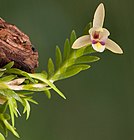Vandeae
| Vandeae | |
|---|---|
Bromheadia brevifolia (Adrorhizinae) Cyrtorchis arcuata (Angraecinae) Trichoglottis atropurpurea (Aeridinae) Polystachya aconitiflora (Polystachyinae) Diversity of Vandeae | |
| Scientific classification | |
| Kingdom: | Plantae |
| Clade: | Tracheophytes |
| Clade: | Angiosperms |
| Clade: | Monocots |
| Order: | Asparagales |
| Family: | Orchidaceae |
| Subfamily: | Epidendroideae |
| Tribe: | Vandeae |
| Type genus | |
| Vanda R.Br.[2] | |
| Subtribes | |
| Synonyms[3] | |
| |
The Vandeae is a large monophyletic tribe within the family of orchids.
Scope


This tribe contains 1,700 - 2,000 species in more than 150 genera.[4]
Epiphytic
These orchids are pantropical epiphytes and occur in tropical Asia, the Pacific Islands, Australia and Africa. Many of these orchids are horticulturally important, especially Vanda and Phalaenopsis.
Subtribes
This tribe is subdivided into four subtribes:[5]
- Subtribe Adrorhizinae
- Subtribe Aeridinae (formerly, illegitimate subtribal name Sarcanthinae): largest subtribe with more than 1,000 species in 103 genera, including about 200 hybrid species; occurs mostly in Asia and Australia and with a few in Africa. They are distinguished from the other subtribes by having an entire rostellum, a relatively small spur formed by the lip, and four (or two) pollinia.
- Subtribe Angraecinae Summerh.: about 400 species in 19 genera. They occur in tropical Africa, Madagascar, the Mascarene and Comoros Islands and two genera in tropical America. They are distinguished from the other subtribes by having an apron-like rostellum, an elongate spur, and two pollinia.
- Subtribe Polystachyinae (formerly part of the Epidendreae) : about 220 species in two genera : Hederorkis and Polystachya. They all show four pollinia. The lip often has mealy hairs called pseudopollen on the upper surface.
The following phylogenetic tree shows the relationships among the subtribes:[6]
| Vandeae s.l. |
| ||||||||||||||||||
The subtribe Aerangidinae Summerh. is increasingly included within Angraecinae. The subtribe Angraecinae is a well supported, monophyletic group under the inclusion of Aerangidinae. Separating these groups would make them polyphyletic.[7][8]
The divergence time of Vandeae has been estimated to be 25.31 Mya.[1]
Gallery
-
Polystachya virginea Summerh., a member of the subtribe Polystachyinae
-
Bromheadia brevifolia Ridl., a member of the subtribe Adrorhizinae
-
Thrixspermum calceolus (Lindl.) Rchb.f., a member of the subtribe Aeridinae
-
Angraecum magdalenae Schltr. & H.Perrier, a member of the subtribe Angraecinae
See also
References
- ^ a b Kim, Young-Kee; Jo, Sangjin; Cheon, Se-Hwan; Kwak, Myounghai; Kim, Young-Dong; Kim, Ki-Joong (2020). "Plastome evolution and phylogeny of subtribe Aeridinae (Vandeae, Orchidaceae)". Molecular Phylogenetics and Evolution. 144: 106721. Bibcode:2020MolPE.14406721K. doi:10.1016/j.ympev.2019.106721. PMID 31870921.
- ^ Missouri Botanical Garden. (n.d.-g). Vandeae Lindl. Tropicos. Retrieved December 2, 2024, from http://legacy.tropicos.org/Name/50169895
- ^ Pridgeon, Alec M.; Cribb, Phillip; Chase, Mark W.; Rasmussen, Finn N., eds. (2014). Genera Orchidacearum: Epidendroideae. Vol. 6 pt 3. Oxford University Press. p. 101. ISBN 978-0-19-964651-7.
- ^ Chase, Mark; Cameron, Kenneth M.; Barrett, Russell L.; Freudenstein, John V. (2003). "DNA data and Orchidaceae systematics: a new phylogenetic classification". In Dixon, K.W.; Kell, S.P.; Barrett, R.L.; Cribb, P.J. (eds.). Orchid Conservation. Natural History Publications. pp. 69–89.
- ^ Simo-Droissart, Murielle; Plunkett, Gregory M.; Droissart, Vincent; Edwards, Molly B.; Farminhão, João N.M.; Ječmenica, Vladimir; d'Haijère, Tania; Lowry, Porter P.; Sonké, Bonaventure; Micheneau, Claire; Carlsward, Barbara S.; Azandi, Laura; Verlynde, Simon; Hardy, Olivier J.; Martos, Florent; Bytebier, Benny; Fischer, Eberhard; Stévart, Tariq (2018). "New phylogenetic insights toward developing a natural generic classification of African angraecoid orchids (Vandeae, Orchidaceae)". Molecular Phylogenetics and Evolution. 126: 241–249. Bibcode:2018MolPE.126..241S. doi:10.1016/j.ympev.2018.04.021. PMID 29673694.
- ^ Freudenstein, John V.; Chase, Mark W. (2015). "Phylogenetic relationships in Epidendroideae (Orchidaceae), one of the great flowering plant radiations: progressive specialization and diversification" (PDF). Annals of Botany. 115 (4): 665–681. doi:10.1093/aob/mcu253. PMC 4343289. PMID 25578379.
- ^ Szlachetko, Dariusz L.; Tukałło, Piotr; Mytnik-Ejsmont, Joanna; Grochocka, Elżbieta (2013). "Reclassification of the Angraecum-alliance (Orchidaceae, Vandoideae) based on molecular and morphological data" (PDF). Biodiversity Research and Conservation. 29: 1. doi:10.2478/biorc-2013-0004.
- ^ Carlsward, Barbara S.; Whitten, W. Mark; Williams, Norris H.; Bytebier, Benny (2006). "Molecular phylogenetics of Vandeae (Orchidaceae) and the evolution of leaflessness". American Journal of Botany. 93 (5): 770–786. doi:10.3732/ajb.93.5.770. PMID 21642140.
- Cameron, Kenneth M.; Chase, Mark W.; Whitten, W. Mark; Kores, Paul J.; Jarrell, David C.; Albert, Victor A.; Yukawa, Tomohisa; Hills, Harold G.; Goldman, Douglas H. (1999). "A Phylogenetic Analysis of the Orchidaceae: Evidence from rbcL Nucleotide Sequences". American Journal of Botany. 86 (2): 208–224. doi:10.2307/2656938. JSTOR 2656938.
- Carlsward, Barbara S.; Whitten, W. Mark; Williams, Norris H.; Bytebier, Benny (2006). "Molecular phylogenetics of Vandeae (Orchidaceae) and the evolution of leaflessness". American Journal of Botany. 93 (5): 770–786. doi:10.3732/ajb.93.5.770. PMID 21642140.







